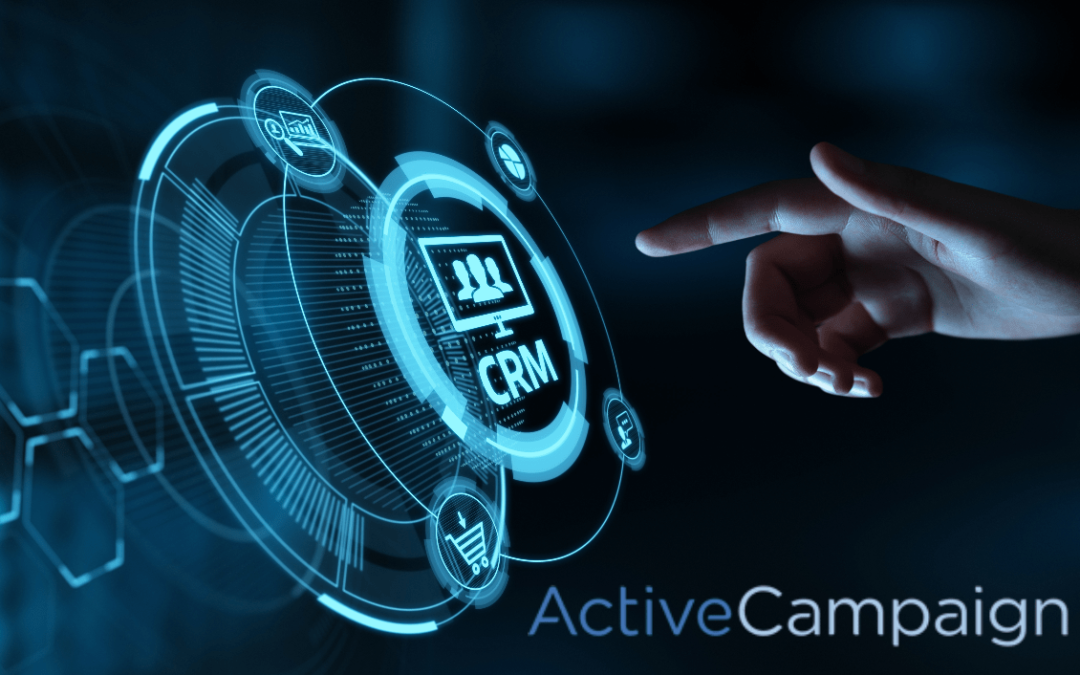ActiveCampaign CRM Review — Must Read Before Starting
Disclosure: We may use affiliate links which means that, at zero cost to you, we may earn a commission if you buy something through our links.
Welcome to our ActiveCampaign CRM review! If you’re reading this, then you’re probably on the market for a powerful email marketing tool that comes with an integrated CRM feature (Customer Relations Management).
The statement above pretty much sums up what ActiveCampaign does. As an all-in-one email marketing platform, the CRM tool has been one of its’ defining features since it was added in 2014.
So is it enough? What makes ActiveCampaign different from other CRM tools out there?
These are all perfectly good questions, and in this review, we’ll help you find all the answers by going through the specific pros and cons of choosing ActiveCampaign as your CRM tool. Only then can you decide if an ActiveCampaign plan is worth your time and money.
ActiveCampaign — What to expect?
Unlike most other CRM tools in the market, ActiveCampaign is primarily an email marketing tool first and a CRM second. This is in stark contrast to most of their competitors who are mainly focused on CRM and only added email marketing as an afterthought.
Now you might be wondering — isn’t putting CRM second a bad thing for ActiveCampaign? This is a review of its’ CRM feature, after all.
Well, not exactly; you see, the problem with marketing tools that are “CRM-first” is that they often do not give enough attention to the email marketing side of things.
ActiveCampaign’s approach is the polar opposite and as a result, serving as a CRM for email marketing is something that they do remarkably well.
The idea behind ActiveCampaign CRM is to provide an automated means of overseeing business opportunities in the midst of sales and email marketing processes.
If your search for a CRM tool stems primarily from a need to automate and optimize your email marketing campaign, then ActiveCampaign is no doubt an excellent option that’s worth considering.
The Pros of using ActiveCampaign CRM
Of course, what you really want to know is whether or not ActiveCampaign can be a big boon to your email marketing business. To find out, we’ll go over the specific pros of using the latter.
Note that you’ll need to sign up for an ActiveCampaign login under the Plus plan (or higher) to get access to their CRM feature.
Here are a few things that we’ve loved about the CRM tool on ActiveCampaign:
Ease of use
If you’ve ever used a number of CRM tools in the past, then you’ve probably noticed how most of them tend to overcomplicate things.
It’s as if they love bombarding their users with jargon and non-essential features. As a result, users have to go through a steep learning curve just to make the most out of what their CRM tool has to offer.
As you can see above, that is not at all the case with ActiveCampaign. They use a card-based pipeline, where deals can be dragged from one stage and moved to another stage as needed.
The approach is similar to productivity management tools like Trello and Proofhub. As you might imagine, this dramatically simplifies the process of contact management wherein users are free to make, change and advance “deals” as ActiveCampaign calls it.
With ActiveCampaign CRM, it’s a simple matter to make deals and link them with existing pipelines or funnels. As you can see above, you’ve got space to set a description and assign a value, pipeline, stage, deal owner, etc.
Of course, you’re not limited to the three stages shown above (To contact, In contact, and Follow Up). Users can delete them and make new ones; as many as you need to reflect your current sales and marketing process.
If you offer different types of products or services, then you can use ActiveCampaign CRM to create individual pipelines for your offers quickly.
It is safe to say that ActiveCampaign is a highly intuitive and versatile CRM tool; one that is more than capable of handling contact management regardless of the scope and complexity of your business.
Pertinent information about contacts and deals can be managed in one place
Another great thing that we loved about ActiveCampaign CRM is the fact that it addresses the failings of most other CRMs when it comes to simplifying contact management.
We won’t be mentioning any names here, but to be specific, you may have noticed how most other CRMs never seem to show all of the information that you need to manage your contacts in one place.
With most other CRMs, users often need to sort through various sections (account, opportunities, contact, etc.) to have a firm grasp on how leads are doing.
If you’re a small business that only has to attend to a few inquiries per day, then you probably aren’t bothered too much by it. However, what if that’s not the case?
What if you are a medium or large-sized business that has to sort through tens or even hundreds of contacts per day? As you might imagine, things can get somewhat chaotic.
This is why we can’t help but appreciate ActiveCampaign’s approach on the matter as you’ll see below.
ActiveCampaign CRM offers a fast and simple means of viewing and managing your contacts in one place.
As you can see above, users have the option to add notes, set tasks, assign goals, send ActiveCampaign emails, and other pertinent actions without having to navigate away from the page.
Any action taken is saved to that contact (or “deal” asActiveCampaign calls it). Hence it’s much easier for users to keep track of leads and what needs to be done to keep the ball rolling.
A UX (user experience) design strategy where all essential information and contact-related management task can be done in one place may not seem all that complicated. However, it’s insights like this which enables ActiveCampaign to stand out from most other CRM tools.
ActiveCampaigns approach to CRM is not only convenient but also helps prevent clutter that only serves to distract users from the ultimate goal — to execute an effective marketing strategy and maximize conversions.
Seamless automation process for sales and marketing
ActiveCampaign is one of the few marketing platforms in the market that combines CRM with email marketing. Having to rely on one platform for two crucial elements of digital marketing means that it better comes with some reliable automation features.
Fortunately, ActiveCampaign does not disappoint in this regard.Automation in ActiveCampaign is some of the most advanced we’ve seen in the market at a price that is well within reach of small to medium-sized businesses.
Perhaps the best thing about choosing ActiveCampaign for your CRM tool is the relative ease by which automation can be integrated to complement your marketing process.
What do we mean by that? Well, for instance, let us say that your business runs a blog, and you want to specifically engage leads who took the time to sign up for your list and read your newsletter.
As you can see above, you’ll have no trouble setting up this workflow using a visual automation tool. You can click on “Add Trigger” to specify conditions that will start the automation.
For this example, the trigger would be “Subscribes to a List”.
You can then click on the “+” button to specify an action once the condition mentioned above is fulfilled. From there, you have several options for engaging your lead, which includes sending a personalized email, or a text message (send SMS).
Users also have the option to notify people in our organization which can be useful for keeping track of deals as they progress through a marketing funnel.
Of course, this is just the basics of what you can do with ActiveCampaign’s CRM and automation tool. Still, that should be enough to give you an idea of just how easy it is to implement the tool to execute any sales or marketing strategy.
While a visual-based automation workflow isn’t at all unique to ActiveCampaign, it is safe to say that their approach is excellent especially when most other CRM tools in the market tend to make automation harder than it should be.
Powerful integration features
Another feature that we loved about ActiveCampaign CRM is that it supports the integration of multiple email accounts and calendars. Again, while these features aren’t unique to ActiveCampaign, having these features is still incredibly helpful.
For example, you can link all of your organization’s email accounts with ActiveCampaign may it be Gmail, Yahoo, Outlook, etc. That way, conversations involving members of your organization and prospects are easily accessible from the CRM.
The same goes for calendars (Google, Any-do, Outlook, etc.) wherein all tasks and appointments can be synced with the CRM. That way, users don’t have to use a different calendar to keep track of how their marketing strategies are progressing.
Lead/Deal scoring feature
We were pleasantly surprised that ActiveCampaign CRM comes with a lead scoring feature, especially at the price that it’s going for ( the Plus plan which starts at $70 per month).
In general, lead scoring is a feature that’s often found on Enterprise-level marketing software like Marketo, Pardot, and Infusionsoft.
Simply put, lead scoring is a revolutionary marketing feature that allows users to home in on leads that are most likely to convert. With it, you can assign scores to individual leads based on certain conditions like demographics and the steps that a lead has taken (or overlooked).
Lead actions include opening/not opening emails, webpages viewed, subscribing/unsubscribing to newsletters, etc.
As hinted above, the conditions for lead scoring are set via automation and can prove useful for pruning out contacts that won’t likely amount to anything. Leads with high scores turn into open deals in the pipeline which are then subjected to what they call “deal scoring”.
Deal scoring similar to lead scoring, except that they only apply to active deals in the pipeline.
As you might imagine, scoring deals in the pipeline enable businesses to gauge which of their leads are ready to convert. As a result, businesses can lend priority to leads with the highest chance of success and maximize conversions.
What about the cons?
Of course, this wouldn’t be a proper ActiveCampaign CRM review if we made no mention of the cons. No digital marketing platform is perfect, and even one that is as reputable as ActiveCampaign has its’ downsides.
One con, in particular, has to do with ActiveCampaign’s reporting tool which offers a general account of how your campaign is faring. Users can choose to view the reports via three formats which include:
Deals Overview
Deal Funnel
Deal Owners
If you’ve used other CRM tools in the past like Zoho and Salesforce, then you might have noticed that ActiveCampaign’s reports aren’t nearly as comprehensive.
You might be able to get around it by exporting the information to a third-party reporting tool, but then you’d have to create a new API to make it happen. Of course, that’s something that users typically wouldn’t want to deal with.
Another downside worth mentioning is that a few of the more advanced features of the ActiveCampaign CRM tool are limited to higher plans. This includes Attribution ( a tool for measuring the effectiveness of marketing activities for influencing conversions).
One other advanced CRM feature is a tool called “Win Probability” which users can leverage to predict which active deals they’re most likely to win.
If you’re interested in any of the advanced CRM features like the ones mentioned above, then you will have to upgrade to a Professional or Enterprise plan. ActiveCampaign pricing for either plan can be costly and outside the reach of most businesses.
To learn more about ActiveCampaign beyond its’ CRM features, you may want to check out our full ActiveCampaign review before making a decision.
Conclusion
So is ActiveCampaign the right CRM tool for you? Well, that depends on how you would answer the following:
- Primarily generate your business through online queries, emails, and automated marketing strategies?
- Find value in being able to set automation workflows quickly and efficiently?
- Can live without granular and personalized marketing reports?
If you’ve answered yes to any of the questions mentioned above, then you’d probably be happy with what ActiveCampaign CRM has to offer.














Thanks for the up to date content. https://www.dealerbaba.com/suppliers/business-services/pinupindia.html
AwesomeWin is an internet-based gambling site known for its wide range of games and user-friendly user interface. With GreatWin, gamblers can enjoy a smooth gaming experience from the convenience of their homes. The GoodWin.am goodwin bonus code and GreatWin casino offer a wide variety of popular gambling game options, including slots, card games, and live dealer options. GreatWin’s commitment to fair play and security ensures that gamblers can enjoy their favorite game options with peace of mind. Whether you prefer the thrill of pokies or the tactical challenge of poker, GoodWin Casino has something for everyone.
gyvemZYMBPOHcTnt
Makasih infonya! Berita di sini selalu up to date dan relevan. Buat yang suka pendekin link, V.af recommended banget! Cek di V.af ya. Terima kasih lagi buat kontennya! 👍😊
Забота о резиденции – это забота о благополучии. Тепловая обработка фасадов – это не только изысканный облик, но и обеспечение тепла в вашем уголке спокойствия. Наша команда, наша команда профессионалов, предлагаем вам преобразить ваше жилище в прекрасное место обитания.
Наши работы – это не просто тепловая обработка, это творческое воплощение с каждым шагом. Мы предпочитаем совершенному сочетанию между формой и содержанием, чтобы ваш уголок стал не только теплым и уютным, но и изысканным.
И самое существенное – удовлетворительная стоимость! Мы уверены, что качественные услуги не должны быть сверхдорогими. Услуги по утеплению стен снаружи стоимость работ начинается всего от 1250 рублей за квадратный метр.
Современные технологии и высококачественные материалы позволяют нам создавать тепловую обработку, которая обеспечивает долговечность и надежность. Позабудьте о проблемах с холодом стен и избежите дополнительных расходов на отопление – наше утепление станет вашим надежным препятствием перед холодом.
Подробнее на http://www.ppu-prof.ru/
Не откладывайте на потом заботу о приятности в вашем доме. Обращайтесь к квалифицированным специалистам, и ваш дом преобразится настоящим художественным творчеством, которое принесет вам не только тепло. Вместе мы создадим пространство, в котором вам будет по-настоящему удобно!
Melhor aplicativo de controle parental para proteger seus filhos – Monitorar secretamente secreto GPS, SMS, chamadas, WhatsApp, Facebook, localização. Você pode monitorar remotamente as atividades do telefone móvel após o download e instalar o apk no telefone de destino.
Уважаемые Друзья!
Предоставляем вам оригинальное концепт в мире декора домашней обстановки – шторы плиссе. Если вы мечтаете к совершенству в каждой подробности вашего жилища, то эти шторы выберутся прекрасным подходом для вас.
Что делает шторы плиссе столькими необычными? Они совмещают в себе лоск, утилитарность и практичность. Благодаря специальной постройке, технологичным материалам, шторы плиссе идеально гармонизируются с для любого другого пола, будь то стая, ложе, плитки или рабочее пространство.
Закажите жалюзи плиссе на пластиковые окна – отразите уют и превосходство в вашем доме!
Чем подсаживают шторы плиссе для вас? Во-первых, их индивидуальный макет, который присоединяет индивидуальность и изысканность вашему месту. Вы можете отыскивать из различных текстур, цветов и подходов, чтобы отметить особенность вашего дома.
Кроме того, шторы плиссе предлагают массивный арсенал функциональных возможностей. Они могут управлять уровень освещения в месте, преграждать от солнечных лучей, поддерживать приватность и создавать уютную обстановку в вашем доме.
Мы веб-сайт: http://www.tulpan-pmr.ru
Мы поддержим вам выбрать шторы плиссе, которые прекрасно гармонируют с для вашего дизайна!
Thank you for your sharing. I am worried that I lack creative ideas. It is your article that makes me full of hope. Thank you. But, I have a question, can you help me?
Мы группа специалистов по поисковой оптимизации, специализирующихся на продвижении сайтов в поисковых системах.
Мы преуспели в своей деятельности и предлагаем вам воспользоваться нашим опытом и знаниями.
Какие услуги мы предоставляем:
• seo продвижение сайтов
• Комплексный анализ вашего сайта и разработка индивидуальной стратегии продвижения.
• Оптимизация контента и технических параметров вашего сайта для лучших результатов.
• Постоянное отслеживание результатов и анализ вашего онлайн-присутствия с целью его совершенствования.
Подробнее https://seo-prodvizhenie-ulyanovsk1.ru/
Наши клиенты уже видят результаты: повышение посещаемости, улучшение позиций в поисковых запросах и, конечно же, рост бизнеса. Мы готовы предложить вам консультацию бесплатно, для того чтобы обсудить ваши требования и помочь вам разработать стратегию продвижения, соответствующую вашим целям и бюджету.
Не упустите возможность повысить эффективность вашего бизнеса в интернете. Свяжитесь с нами прямо сейчас.